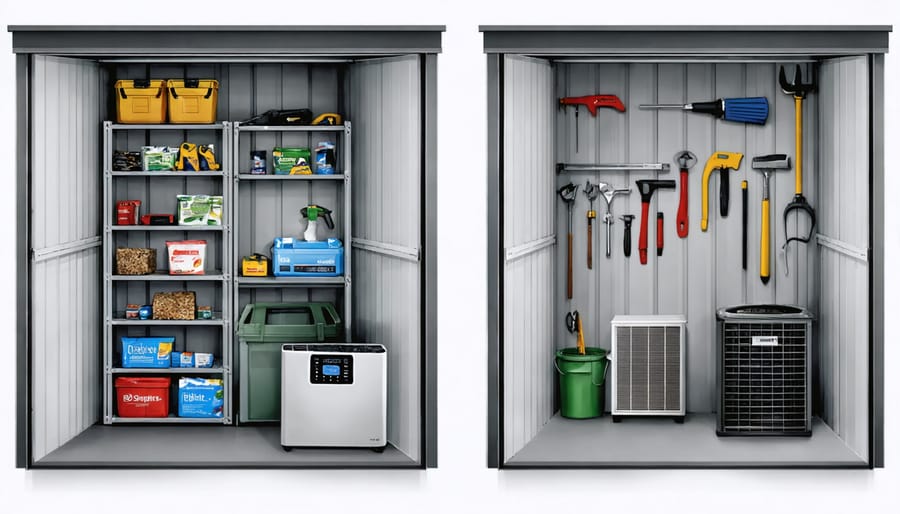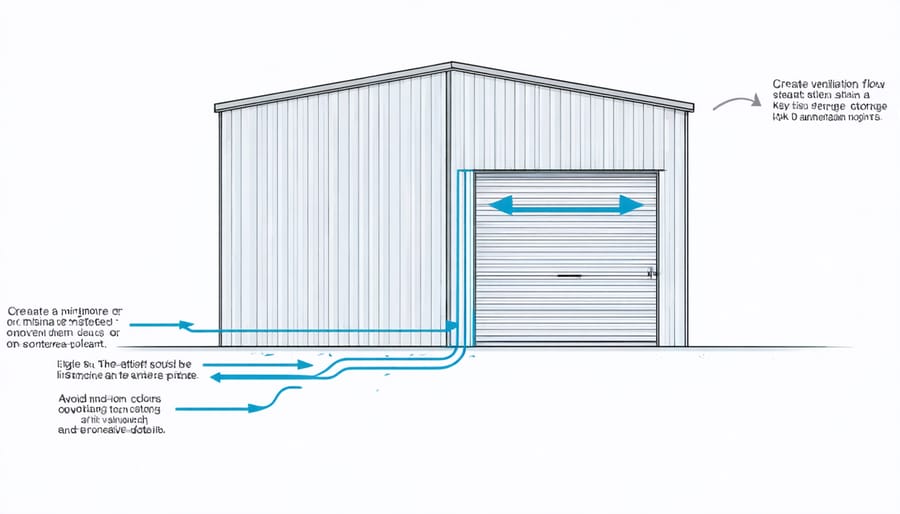Keep Your Shed Dry: Simple Solutions That Actually Work

Protect your valuable belongings and preserve your storage space by mastering humidity control in your shed or storage area. Excess moisture silently damages everything from tools and electronics to precious family heirlooms, causing rust, mold, and deterioration that can cost thousands in replacements. Modern humidity control solutions combine smart technology with practical design to maintain the perfect moisture balance year-round, ensuring your stored items remain in pristine condition.
A well-regulated storage environment does more than just prevent damage – it creates a reliable space where you can confidently store anything from sensitive documents to seasonal decorations. Whether you’re dealing with a damp basement, a backyard shed, or a climate-controlled storage unit, understanding and implementing proper humidity control measures is essential for protecting your investments and maintaining peace of mind.
This guide explores proven strategies for maintaining optimal moisture levels, from simple DIY solutions to advanced humidity control systems, helping you create the perfect storage environment for your specific needs.
Why Humidity Control Matters in Your Shed
Signs of Humidity Problems
Being vigilant about humidity problems in your storage shed can help you take action before serious damage occurs. Watch for musty odors, which are often the first sign of excess moisture. If you notice condensation forming on windows, walls, or metal surfaces, this indicates high humidity levels that need to be addressed to prevent moisture buildup.
Look for warped or swollen wooden items, including doors that suddenly become difficult to open or close. Rust spots on metal tools, hardware, or shelving are clear indicators of moisture issues. Pay attention to any mold or mildew growth, which typically appears as dark spots on walls, ceilings, or stored items.
Other warning signs include peeling paint or wallpaper, dampness on concrete floors, and water stains on walls or ceilings. If you notice your stored cardboard boxes becoming soft or deteriorating, this often points to excessive humidity. Even seemingly minor signs, like a sticky feeling in the air or foggy windows, shouldn’t be ignored as they can signal developing moisture problems.
The Real Cost of Moisture Damage
Moisture damage can silently wreak havoc on your valuable possessions and the structure of your storage shed. Tools and metal equipment are particularly vulnerable, developing rust and corrosion that can render them unusable. A wrench or saw left in high humidity conditions might work perfectly one day, only to show signs of rust the next.
Wood-based items aren’t safe either. Excess moisture causes wooden handles to swell, warp, and eventually rot, while power tools can suffer from internal damage when humidity seeps into their components. Even your shed’s framework isn’t immune – persistent moisture can lead to wood rot, weakening the entire structure and potentially requiring costly repairs.
Garden chemicals and fertilizers stored in humid conditions may clump together or lose their effectiveness. Electronics and anything with circuitry are especially at risk, as high humidity can cause short circuits and permanent damage. The financial impact adds up quickly – replacing tools, repairing equipment, and fixing structural damage can cost hundreds or even thousands of dollars if humidity isn’t properly controlled.

Practical Humidity Control Methods
Natural Ventilation Techniques
Natural ventilation offers a cost-effective way to control humidity in your storage space without relying on electricity. By implementing proper ventilation techniques, you can maintain a healthy environment for your stored items while keeping energy costs down.
Start by installing soffit vents near the roof eaves to allow fresh air intake. These work in harmony with ridge vents at the roof peak, creating a natural airflow that pushes warm, humid air up and out. For maximum effectiveness, place vents on opposite walls to encourage cross-ventilation, which helps maintain consistent air circulation throughout your storage space.
Gable vents are another excellent addition, particularly for larger storage structures. Installing these circular or triangular vents at each end of your storage space helps prevent hot air from becoming trapped at the roof peak. For ground-level ventilation, consider adding foundation vents that allow air to circulate beneath your storage structure, preventing moisture from seeping up through the floor.
Remember to keep stored items slightly away from walls and raised off the floor using pallets or shelving. This simple practice promotes air movement around your belongings and reduces the risk of moisture damage. During particularly humid days, leaving your storage door open for a few hours can provide additional airflow, though be sure to close it before evening when humidity typically rises.

Dehumidifier Options
When it comes to managing moisture in your storage space, choosing the right dehumidifier can make all the difference. Portable dehumidifiers are popular for smaller storage areas, offering flexibility and ease of use. These units typically come with adjustable humidity settings and removable water tanks, making them perfect for spaces up to 500 square feet.
For larger storage areas, consider investing in a whole-space dehumidifier that connects directly to your drainage system. These units work continuously without requiring manual emptying and can effectively control humidity in areas up to 2,500 square feet or more.
Desiccant dehumidifiers work well in unheated spaces and colder temperatures, making them ideal for uninsulated storage areas. They’re particularly effective during winter months when compressor-based units might struggle to perform.
Mini dehumidifiers can be perfect for small, enclosed storage spaces like cabinets or closets. These compact units are energy-efficient and require minimal maintenance, though they need regular emptying due to their smaller capacity.
Smart dehumidifiers offer remote monitoring and control through your smartphone, allowing you to track humidity levels even when you’re away. Many feature auto-shutoff functions and can send alerts when the water tank needs emptying or when humidity levels spike unexpectedly.
Remember to choose a unit with an appropriate capacity for your space – bigger isn’t always better, and an appropriately sized dehumidifier will operate more efficiently and economically.
Moisture-Absorbing Products
Keeping your storage space dry is easier with the right moisture-absorbing products. Silica gel packets, those small sachets you often find in new purchases, are excellent for small spaces and containers. While single-use packets work well, consider investing in reusable silica gel containers that can be “recharged” in the oven when they become saturated.
Calcium chloride-based products, available in bucket or hanging bag form, are powerful moisture absorbers perfect for larger storage areas. These products typically last 2-3 months and can collect several times their weight in water. Place them in corners or hang them where moisture tends to accumulate for best results.
Natural alternatives like activated charcoal and bamboo charcoal bags offer eco-friendly moisture control while also helping eliminate odors. These can last up to two years with proper maintenance and regular sun exposure to “reactivate” their absorbing properties.
For a budget-friendly option, clay-based cat litter in open containers can effectively reduce humidity levels. Rock salt is another affordable alternative, though it requires regular replacement and careful handling to prevent corrosion of nearby metal items.
Remember to check and replace your moisture absorbers regularly according to manufacturer guidelines. Position them away from stored items to prevent direct contact, and consider using multiple products in different locations for maximum effectiveness.
Preventive Measures

Proper Storage Practices
Implementing proper storage solutions is crucial for maintaining optimal humidity levels in your storage space. Start by elevating items off the floor using pallets or shelving units, which promotes better air circulation and prevents direct contact with potentially damp surfaces.
Create designated zones within your storage area based on item sensitivity to moisture. Keep electronics, paper documents, and fabrics in sealed plastic containers with silica gel packets. For power tools and metal items, consider using vapor corrosion inhibitor (VCI) bags or wrapping them in moisture-barrier materials.
Stack boxes and containers with space between them and the walls, allowing air to flow freely. Avoid overcrowding, as tight spaces can trap moisture and create ideal conditions for mold growth. Use clear plastic bins when possible to easily monitor contents for any signs of moisture damage.
For seasonal items, rotate storage positions periodically to ensure even air exposure. Store frequently used items at eye level and in easily accessible locations to minimize disruption to your organization system. Consider using labels to track contents and maintain an inventory system.
Place moisture-sensitive items away from windows or areas prone to temperature fluctuations. Use breathable covers for large equipment or furniture, avoiding plastic tarps that can trap moisture. Remember to check stored items regularly and reorganize as needed to maintain optimal airflow throughout your storage space.
Maintenance Tips
Regular maintenance is key to keeping humidity levels in check within your storage space. Start by establishing a monthly inspection routine where you check for signs of moisture intrusion, condensation, or mold growth. Pay special attention to corners, joints, and areas around windows or vents where moisture tends to accumulate.
Clean your dehumidifiers’ filters monthly and empty water collection tanks as needed – usually every few days during humid seasons. If you’re using desiccant packets or moisture absorbers, replace them according to the manufacturer’s recommendations, typically every 2-3 months.
Ensure your ventilation system remains unobstructed throughout the year. Clear any debris from vents, and test mechanical ventilation fans quarterly to confirm they’re operating efficiently. It’s also crucial to protect your shed’s foundation by maintaining proper drainage and checking for any ground-level moisture issues.
During seasonal changes, adjust your humidity control settings accordingly. In winter, you might need less dehumidification, while summer months typically require more aggressive moisture management. Keep a log of humidity readings and any adjustments made – this helps track patterns and optimize your control strategy.
Don’t forget to inspect weather stripping around doors and windows annually, replacing any damaged sections promptly. Check your roof and walls for leaks or damage during spring and fall, addressing any issues immediately to prevent moisture from compromising your storage environment. Regular maintenance not only extends the life of your humidity control system but also ensures better protection for your stored items.
Managing humidity in your storage space doesn’t have to be a constant battle. By implementing the strategies we’ve discussed, you can create a safe, dry environment that protects your valuable belongings for years to come. Remember that effective humidity control starts with proper building design and ventilation, supported by monitoring tools and moisture-absorbing solutions.
Take action today by assessing your storage space’s current condition. Start with simple steps like installing a hygrometer and checking for any existing moisture issues. Then, gradually implement more comprehensive solutions such as improved ventilation, dehumidifiers, or moisture-absorbing products based on your specific needs.
Regular maintenance and periodic checks will help you stay ahead of potential moisture problems. Don’t wait for visible signs of damage – prevention is always more cost-effective than repairs. By maintaining optimal humidity levels between 30% and 50%, you’ll create an environment where your stored items remain in pristine condition.
Whether you’re protecting family heirlooms, seasonal decorations, or everyday tools, proper humidity control is an investment in preserving what matters to you. With these solutions in place, you can rest assured that your belongings are protected from moisture damage, mold, and mildew. Take the first step today toward creating a better storage environment for tomorrow.

